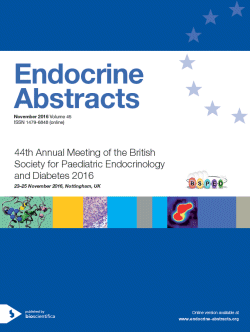
44th Meeting of the British Society for Paediatric Endocrinology and Diabetes
Poster Presentations
Diabetes
ea0045p12 | Diabetes | BSPED2016
Identifying the barriers to effective diabetes ‘transitional care’. A qualitative study of patient satisfaction and experiences of transition
Wilson Kate , Ashford Jennifer , Olsen Paula , Slegtenhorst Sonja , Williams Rachel , Acerini Carlo L
ea0045p13 | Diabetes | BSPED2016
Practical Elements for Successful Recruitment of Patients and Families with Newly Diagnosed Type 1 Diabetes (T1DM) into a Research Study
Saddington Caroline , Mohamed Zainaba , Sachdev Pooja , Denvir Louise , Randell Tabitha
ea0045p14 | Diabetes | BSPED2016
Identifying the barriers to diagnosing type 1 diabetes in young people in the primary care setting
Suo Chenqu , Wilson Kate , Acerini Carlo
ea0045p15 | Diabetes | BSPED2016
Severe acute renal failure requiring dialysis in children with diabetic ketoacidosis
Paraskevopoulou Evagelia , Peacock Amanda , Patel Leena , Burren Christine , Yong James , Bain Murray , Wei Christina
ea0045p16 | Diabetes | BSPED2016
An Audit of the Paediatric Diabetes Out Of Hours Advice Service using the Best Practice Tariff Criteria
Starr Emma , Quintela Ella , Denvir Louise , Sachdev Pooja
ea0045p17 | Diabetes | BSPED2016
Acute surgical abdomen masquerading as diabetic ketoacidosis
Kanumakala Shankar , Fonseka Geetha , Karunaratne Irantha , Alexander Nicholas
ea0045p18 | Diabetes | BSPED2016
Hypoglycaemia – are children carrying the right sugars?
ea0045p19 | Diabetes | BSPED2016
It’s all about the HbA1cs but don’t forget the LFTs…
ea0045p20 | Diabetes | BSPED2016
Acute mononeuropathy as a first presentation of Type 1 Diabetes Mellitus
Kapoor Sonal , Sundaram Prem , Tziaferi Vaya , Prasad Manish
ea0045p21 | Diabetes | BSPED2016
Efficacy and uptake of an education clinic integrated into an MDT clinic for children with type 1 diabetes
Quintela Ella , Drew Josephine , Denvir Louise , Randell Tabitha , Sachdev Pooja
ea0045p22 | Diabetes | BSPED2016
Structured education and competency in adolescents and families with type 1 diabetes mellitus (T1DM)
ea0045p23 | Diabetes | BSPED2016
Unusual presentation of a rare netabolic disorder in an adolescent with T1D with recurrent DKA and steatohepatitis
Gangadharan Arundoss , Paul Princy , Venkatesh Krishnappa , Morris Andrew , Kerr Sue , Ghatak Atrayee , Senniappan Senthil
ea0045p24 | Diabetes | BSPED2016
A case of Mauriac Syndrome
Danda Nandita , Tharian Kavitha
ea0045p25 | Diabetes | BSPED2016
Management of Paediatric Diabetic Ketoacidosis: An Audit
Gollins Charlotte , Javed Muhammad , Muhammad BJ
ea0045p26 | Diabetes | BSPED2016
Ensuring complete data for the national paediatric diabetes Audit – An Approach Using Python
Price Victoria , Shah Akhil , McGuigan Michael
ea0045p27 | Diabetes | BSPED2016
Audit of screening investigations and delay in referral for children with newly diagnosed type I diabetes
Coxson Edward , Balapatabendi Mihirani
ea0045p28 | Diabetes | BSPED2016
Lessons learnt from a case of childhood obesity with Hyperosmolar Hyperglycaemic state (HHS) and severe acidosis
ea0045p29 | Diabetes | BSPED2016
Audit on metabolic effect of insulin pump therapy vs. pen for children with Type 1 Diabetes
ea0045p30 | Diabetes | BSPED2016
A case of neonatal Diabetes: Diagnostic and management challenges
ea0045p31 | Diabetes | BSPED2016
Introducing Dedicated Annual Review Clinics for Children with Type I Diabetes Mellitus in Gloucestershire: Results from a two-year service improvement and evaluation
Coxson Edward , Hawksley Jessica , Unsworth Rebecca , Balapatabendi Mihirani
ea0045p32 | Diabetes | BSPED2016
Emergency advice for families of children with diabetes – the story of a helpline
Grosser Sabine , Alexander Vicky
ea0045p33 | Diabetes | BSPED2016
Does increase in funding and service provision improve outcomes of patients with diabetes? An evaluation of HbA1c in paediatric patients with diabetes at Peterborough City Hospital
Keene Eleanor , Puthi Vijith , Kent Alison
ea0045p34 | Diabetes | BSPED2016
Continuous Subcutaneous Insulin Infusion results in better glycaemic control and reduced insulin requirements in CFRD: Report of 2 cases in children
Trewella E F , Spowart K , Nambisan A Kesavath Raman , Nolan SE , Carr S , Balfour-Lynn I M , Alexander Saji , Bridges Nicola
ea0045p35 | Diabetes | BSPED2016
Assessing the impact of a youth worker on diabetes care in adolescents with type 1 diabetes
Peacock Amanda , Guest Matthew , Cropper Julie , Trentham Sarah , Clarke Michelle , Yong James , Campbell Fiona
ea0045p36 | Diabetes | BSPED2016
A critical review of type 1 diabetes new patient education programme at a single tertiary centre
Uday Suma , Avann Charlotte , Barrett Timothy , Dias Renuka , Drummond Lesley , Kershaw Melanie , Krone Ruth
ea0045p37 | Diabetes | BSPED2016
The highs and the lows: Glycaemic control and socio-economic factors in paediatric patients with type 1 Diabetes in Blantyre, Malawi
Blackstock Sarah , Kasiya Marrianne , Dube Queen
ea0045p38 | Diabetes | BSPED2016
Introduction of an intensive outpatient education programme is acceptable to parents of children, and young people with newly diagnosed type 1 Diabetes
Kershaw Melanie , Krone Ruth , Drummond Lesley , Dias Renuka , Barrett Timothy
ea0045p39 | Diabetes | BSPED2016
Management of diabetes in a refugee child- the challenges
Madhusudhana Madhavi , Randle Emma , Denial Mark , Wright Neil
ea0045p41 | Diabetes | BSPED2016
High HBA1c pathway for children and young people with poor glycaemic control: process and outcomes
Fradley Wayne , Sachdev Pooja , Randell Tabitha , Denvir Louise
ea0045p42 | Diabetes | BSPED2016
The seven wonders of diabetes: An audit of the NICE key age specific care processes
ea0045p42a | Diabetes | BSPED2016



